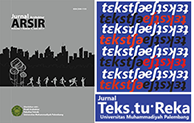Perilaku Pengguna Toilet Umum
Sari
Going to public toilets is not an option but a necessity, while the design and amenities of public toilets at the Mall offered are more oriented to Western standards, with perspectives around luxury, meditation, health, and cleanliness, without the study of how the user community perceives toilets according to their culture. The phenomena of culture shock due to failure to adapt often results in misconduct. This study aims to find the phenomenon of misconduct in the use of public toilet facilities and their causes. Involving 318 random purpose informant samples of public toilet users in the six Palembang Mall, collecting data using questionnaires and interviews, the data were processed with a central tendency analysis for three variables. The results found maladjusment at seating toilet by 24.53% of users, 66.10% in the use of Jetspray, leaving the toilet without washing hands in washtafel 75.93% and not using the hand drayer 72.59%, caused by 45,15% of users are unfamiliar, avoid impure 31.63%, cleanliness 34.26%, and afraid of being dirty 23.22%.
Kata Kunci
Teks Lengkap:
PDF (English)Referensi
Anggoro, (2015) Analisis Faktor yang Berhubungan dengan Pemanfatan Jamban di Kawasan Perkebunan Kopi, e-Jurnal Pustaka Kesehatan, ISSN 2721-3218, Vol. 3, No. 1, pp. 171-178, 2015
ASEAN Secretariat, 2016, ASEAN Public Toilet Standard, ASEAN Secretariat Public Outreach and Civil Society Division, ISBN 978-602-098007608, Jakarta, 2016
Asosiasi Toilet Indonesia (ATI), 2016, Understanding of Public Toilet, Expo Clean 2016
Cassidy, T., 1997, Environmental psychology: Behavior and experience in context, Psychology Press, Hove, East Sussex, 1997.
Clark, C. 2011. No Shit, The History of Wiping - A Book You Can Wipe Your Butt It!, Caleb Clark on Lulu.com, 2011.
Erkip, F., Demirkan H., and Pultar, M., 1997, Knowledge acquisition process for design education, Proc. of IDATER, Loughborough University Publishers, Loughborough, pp126-132, 1997
Genç, M., 2009, The Evolution of Toilets and Its Current State, Ankara: Graduate School of Natural and Applied Sciences of Middle East Technical University, 2009
Greed, C., 2003, Inclusive Urban Design, Public Toilet, Oxford: Architectural Press, Elsevier, 2003.
Hayana, Marlina, H., dan Kurnia, A., 2018, Hubungan Karakteristik Individu dan Lingkungan Sosial Terhadap Perilaku Buang Air Besar Sembarang, Jurnal Kesaehatan Komunitas KESKOM, ISSN.2088-7612, Vol. 4, No. 1, pp. 9-15, 2018
Lang, J., 1987, Creating architectural theory: The role of the behavioral sciences in environmental design, Van Nostrand Reinhold, New York, 1987.
Martosenjoyo, T., 2016, Budaya Bertoilet: Duduk atau Jongkok?, Jurnal Etnosia, Vol. 01, No. 01, pp 44-59, 2016
Molotch , H. 2010. ‘Introduction: Learning from the Loo’, dalam H. Molotch & L. Norén (eds.), Public Restrooms and The Politics of Sharing. New York: New York University Press, pp 1-22., 2010
Pennycook, A. 1998. English and the Discourses of Colonialism. London: Routledge, 1998.
Rybczynski, R., 1989, Making space, The most beautiful house in the world. Penguin Publishers, New York, pp45-67, 1989.
Sobur, Alex, 2003. Psikologi Umum, Bandung: Pustaka Setia, 2003.
Sohrabi, S., Malekzadeh, R., Ansari, R., & Kamangar, F., 2012, ‘Squatting and Risk of Colorectal Cancer: A Case-Control Study’, Middle East Journal of Digestive Diseases, 4(1), pp 23-27, 2012.
Wang, D., 2002, Theory in relation to method. In L. Groat and D. Wang, (Eds.) Architectural research methods, John Wiley and Sons, Inc., New York, pp73-98, 2002
Williams, C. 2010. Southeast Asia on a Shoestring - Ebook Edition. Lonely Planet, 2010.
Willis, S. Sofyan, 2010, Remaja dan Masalahnya, Bandung: Alfabeta, 2010.
Yu, S. 2012. Cahng'an Avenue and the Modernization of Chinese Architecture, Washington: The University of Washington Press, 2012.
DOI: https://doi.org/10.32502/arsir.v4i1.2416
Refbacks
- Saat ini tidak ada refbacks.
Indexed by:

Arsir : Jurnal Arsitektur is lisenced under a Creative Commons Attribution-ShareAlike 4.0 International License.









